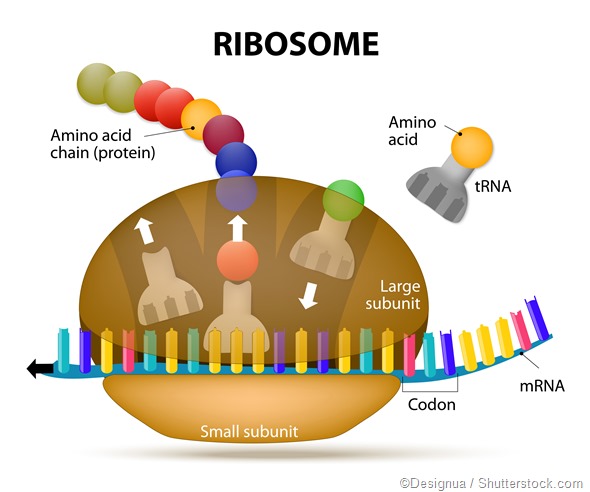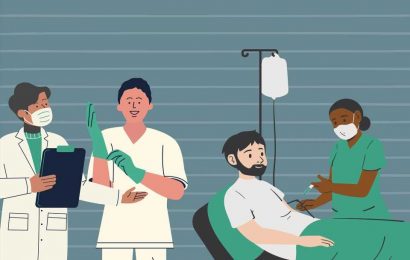A ribosome is a complex macromolecular structure in the cell which is involved in the process of translation. This is an essential function of all living cells, allowing for the production of proteins and all manner of biological structures.
Ribosomes function by linking amino acids together (at a rate of up to 200 a minute) in the order specified by mRNA (messenger RNA) molecules, which in turn transcribe the information contained in DNA. A large protein can take 2-3 hours to be translated. Once a chain of amino acids has been completely translated, it is ejected into the cell cytoplasm and folded into a functional protein.
There are two subunits that comprise the ribosome: the large and small subunits. The small subunit reads the mRNA, whilst the large subunit links the amino acids together (which are carried to the ribosome by transfer tRNA – transfer RNA – molecules) into a polypeptide chain. These subunits consist of ribosomal RNA (rRNA) molecules and ribosomal proteins (rProtein.)

Where is the ribosome made?
The ribosome (which, along with its associated molecules, is also termed the translational apparatus) is synthesized in the nucleolus. This is a small, dense spherical structure located within the nucleus. There are three structures in the nucleolus which perform various functions in ribosome production: the granular component (pre ribosome assembly) fibrillar center (rRNA transcription) and the dense fibrillar component (pre-rRNA processing.)
Once the ribosome is made it passes from the nucleus into the rest of the cell. There, it will carry out its function and translate proteins for use within the cell.
Free and membrane-bound ribosomes
Once within the cell, ribosomes are classed as either free or membrane-bound.
Free ribosomes are found in the cytoplasm and produce proteins for use within the cell. They can move around the cytosol freely but are excluded from organelles and the nucleus.
Membrane-bound ribosomes are found on the membranes of organelles. In eukaryotic cells, this occurs in a region of the endoplasmic reticulum (ER) referred to as the “Rough ER”. These membrane-bound ribosomes are used to synthesize proteins that are required by some organelles, and polypeptide chains produced by these ribosomes are directly bound to the ER through vectorial synthesis and are then transported to their destination by the secretory pathway. The proteins produced by bound ribosomes are used within the plasma membrane or, through exocytosis, expelled from the cell for use elsewhere.
Mutations in the ribosome
Much like the genome itself, mutations can occur within the ribosome which affect the formation of proteins and healthy function of the organism. Ribosomal function is crucial to survival, as any error in the translation process can lead to mutations in the protein being synthesized.
Mutations can exist in the large and small subunits. Mutations in the small subunit can lead to conditions such as Treacher Collins syndrome, an autosomal dominant disorder. This causes abnormality in the bones of the face, as well as the ears and eyes. Mutations in the large subunit can lead to such conditions such as Shwachman-Bodian syndrome. A major symptom of this condition is pancreatic inefficiency caused by the adipose tissue replacing pancreatic tissue.
Other mutations can exist, with varying degrees of severity.
Origin of the ribosome
It is theorized that there existed at one time an “RNA world”, which is a hypothetical stage in the evolution of life on Earth. Ribosomes are thought to have existed in this ancient world as self-replicating constructs which interacted with the first amino acids that appeared, which led to the development of DNA and proteins, which allowed for the complexity and function of life that evolved after this period of evolutionary history.
In eukaryotic organisms, mitochondria and chloroplasts contain their own ribosomes which differ from other parts of the cell in that they strongly resemble prokaryotic ribosomes. This evidence reinforces the theory that these structures were originally prokaryotic organisms that entered into a symbiotic relationship with eukaryotic cells.
As the cell evolved, forming the basis of all life that exists on Earth today, the ribosome became just one part of its many complex structures, albeit one of the most important ones in the entire cell without which life could not exist.
Sources
- Moore, P.B & Steitz, T.A (2002), The involvement of RNA in ribosome function, Naturevolume 418, pages 229–235, https://doi.org/10.1038/418229a
- Ribosome (British Society for Cell Biology), https://bscb.org/learning-resources/softcell-e-learning/ribosome/
- Neveu, M et al. (2013), The “Strong” RNA World Hypothesis: Fifty Years Old, Astrobiology vol. 13 Issue 4 pgs. 391-403, https://doi.org/10.1089/ast.2012.0868
- Copley, S.D et al. (2007), The origin of the RNA world: Co-evolution of genes and metabolism, Bioorganic Chemistry Vol. 35, Issue 6 pgs. 430-443, https://doi.org/10.1016/j.bioorg.2007.08.001
Further Reading
- All Cellular Biology Content
- Structure and Function of the Cell Nucleus
- What Are Organelles?
- Ribosome Structure
- Protein Production: Initiation, Elongation and Termination
Last Updated: Oct 22, 2019

Written by
Reginald Davey
Reg Davey is a freelance copywriter and editor based in Nottingham in the United Kingdom. Writing for News Medical represents the coming together of various interests and fields he has been interested and involved in over the years, including Microbiology, Biomedical Sciences, and Environmental Science.
Source: Read Full Article


